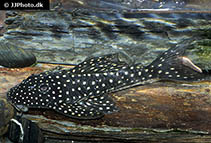| Family: |
Loricariidae (Armored catfishes), subfamily: Hypostominae |
| Max. size: |
24.33 cm SL (male/unsexed) |
| Environment: |
demersal; freshwater; pH range: 6.8 - 7.1 |
| Distribution: |
South America: Paraná river in Argentina. |
| Diagnosis: |
Dorsal spines (total): 2-2; Dorsal soft rays (total): 7-7; Anal spines: 1-1; Anal soft rays: 4-4. Differs from its congeners by the following combination of characters: dorsum of head and body and all fins dark grey covered by numerous rounded cream dots; ventral surface of head and belly a plain cream color; 66-85 premaxillary/dentary teeth; cleithral width 3.0-3.4 in SL; abdominal length 3.9-4.5 in SL; eye diameter 5.2-6.2 in HL; pelvic fin-spine length 3.9-4.5 in SL; caudal peduncle depth 8.3-9.6 in SL; upper caudal-ray length 2.8-3.6 in SL; lower caudal-ray length 2.4-3.5 in SL; right mandibular ramus 3.9-4.6 in HL; dorsal spine length with mean 31.6 % SL; length of right mandibular ramus 3.9-4.6 in HL; abdominal length 3.9-4.5 in SL; head depth 1.6-1.7 in HL;, interorbital width 2.6-3.0 in HL; predorsal length 2.3-2.6 in SL; pectoral-fin spine length 2.8-3.3 in SL; caudal peduncle length 3.0-3.6 in SL; scutes along lateral line 26-28 (mode 27); scutes between end of dorsal fin to adipose fin 5-6 (mode 6) ; scutes from adipose to caudal fins 3-5 (mode 5), and scutes from anal to caudal fins 12-14 (mode 14) (Ref. 91776). |
| Biology: |
Found in coastal areas of main river channel with bottom composed mostly by large boulders of sandstone with patches of sand and pebbles. Occurs in well oxygenated waters having moderate current speed, about 0.60 m s-1, water transparency of 1.5-2.40 m and conductivity of 50.9-59.6 μS cm-1 . Sympatric with Hypostomus commersoni, H. cochliodon,, H. uruguayensis, H. latifrons, H. ternetzi, H. luteomaculatus, H. microstomus, and H. boulengeri (Ref. 91776). |
| IUCN Red List Status: |
Not Evaluated (N.E.) Ref. (130435)
|
| Threat to humans: |
harmless |
Source and more info: www.fishbase.org. For personal, classroom, and other internal use only. Not for publication.

